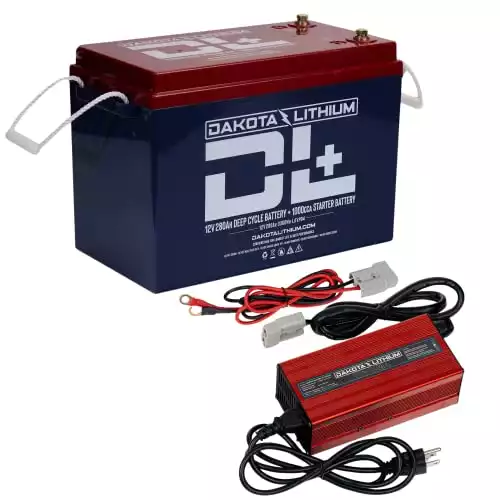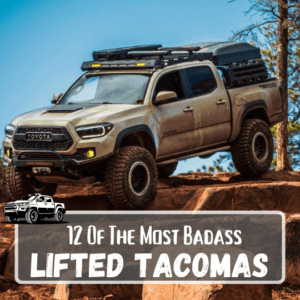
One of the worst feelings is being out in the middle of nowhere and your vehicle not starting.
I had this happen to me recently while on an overlanding trip, even though my truck is only a few years old. It was at that moment I decided to upgrade to a dual battery setup.
But this type of setup is a little complicated. So I did a ton of research and experimentation. Here’s everything that I learned about how to choose and set up dual batteries in your truck, camper, or SUV.
*Note that I am not an electrician and you should always consult a professional if you aren’t sure what you’re doing with DIY!
Things to Know Before You Upgrade to a Dual Battery System
- Work out how much power you’ll need per day with a Wattmeter or this formula: Daily power needs (watts) = Hours of use per day x amps drawn per hour x volts
- A traditional lead acid or AGM dual battery setup for overlanding can cost between $600-$1,000. This can rise to $1,000+ if you use quality AGM or lithium batteries.
- New lithium deep-cycle batteries have been created to act as complete replacements for dual-battery setups. Lithium-metal batteries and lithium iron phosphate (LiFePO4) are two of the most popular types with different advantages and disadvantages.
- Solar generators can be great if you’ll be traveling somewhere sunny (like the desert). However, depending on your budget, a traditional dual battery setup may be more cost-effective if you’re looking for more than 1500 watt hours capacity.
- Wiring multiple battery terminals to an alternator can cause it to overheat and melt if not done correctly. If you’re unsure, consult a professional.
- Keep in mind that you should always have more power than you need to avoid draining the battery too low. This ensures your battery lasts the full expected life.
This long-lasting 200 Amp Hour Lithium Iron Phosphate from LiTime has been an amazing house battery for overland trips.
Use coupon code "AOTR" for 4% off your order!
If you only need to power lights and small appliances, this 100Ah LiFePO4 battery is the perfect addition to your kit.
Use coupon code "AOTR" for 4% off your order!
Determine Your Power Needs
The first thing to consider when deciding to add a dual battery system to your rig is exactly how much power you’re going to need. This is a little tedious, but ensures you have enough power to run everything you want to and your battery system lasts a long time.
First, write down all of the items you’ll want to run off of your batteries. This includes laptops, phones, camera batteries, fridges, tent fans, etc.
Once you have your gear list, you’re going to have to figure out how much power each of these items will require. One of the largest drains to my batteries is my 12 volt fridge.
You can invest in a Wattmeter to figure this out. This measures the power usage of your devices.
Otherwise, you can do it manually. Check out the power supply label on each of your items and battery chargers for the amperage and use this formula:
If you don't know the Wh of the appliace, use this: Daily Power Needs (in Watts) = Hours of Use Per Day x Amps Drawn Per Hour x Volts Or, if you know the Wh of the appliance, use this: Daily Power Needs (in Watts) = Hours of Use Per Day x Watt Hours of Device (Wh)
For example, let’s say you have a laptop that takes one hour to charge. It draws around 15 amps when charging on 12 volt DC (direct current) and lasts for 48 hours after that.
So your power need for your laptop would be:
1 hour x 15 amps x 12 volts = 180 Wh (watt-hour)
Divided by 2 (since a charge lasts 48 hours), this would mean your daily power need for your laptop comes to roughly 90 Wh.
Here’s how the rest of your list might work out:
- Cellphone = 15 Wh
- Laptop = 90 Wh
- Fridge = 256 Wh
- LED lights = 2 Wh
- Fan = 192 Wh
Adding up your Wh estimates for all of your items will give you a good baseline. For this setup, you’d need 555 Wh, which would mean you should have at least a 100 Ah 12V battery.
Now, 100 Ah at 12V is actually 1,280 Wh. So why do I recommend that if you’re only using 555 Wh? Because you should never let your batteries get below a certain percentage (50% for AGM and 20% for lithium), otherwise you risk drastically lowering the life of your battery. So a 1,280Wh battery actually only has 1,024Wh of effective usable energy if you want your battery to last it’s full life.
Decide on a Budget for Your Dual Battery Setup
Now you know your power requirements, you need to work out how that fits into your budget. Dual battery setups use two batteries for different requirements:
- A main battery (“starting battery”) for engine and vehicle usage.
- A secondary battery (“house battery”) for home comforts.
The amount you spend on your dual battery setup will depend on a few factors:
- How long will you be off-grid?
- Will you only charge using the alternator, or will you also implement solar power?
- Do you travel solo or in a group?
For the odd weekend trip, you could get away with not spending as much. If you’re going to be wild camping for multiple weeks of the year, you’ll want to invest in a more robust, reliable dual battery setup.
Keep in mind that Lithium is going to be the most expensive, but also the most capable and reliable battery type.
This long-lasting 200 Amp Hour Lithium Iron Phosphate from LiTime has been an amazing house battery for overland trips.
Use coupon code "AOTR" for 4% off your order!
If you only need to power lights and small appliances, this 100Ah LiFePO4 battery is the perfect addition to your kit.
Use coupon code "AOTR" for 4% off your order!
Choose Your Dual Battery Kit
A traditional dual battery setup uses an isolator that charges both batteries separately. This means if anything goes wrong with one, the other isn’t affected.
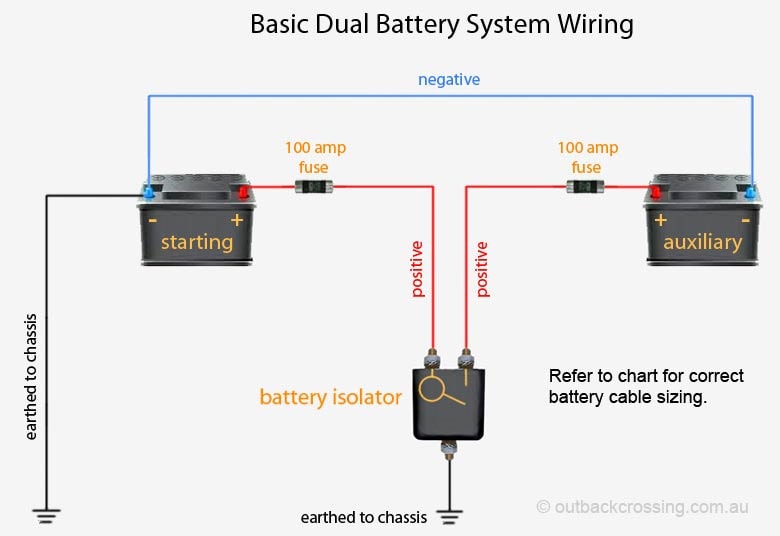
If your house battery dies, you’ll still be able to move your vehicle. Here’s how it works:
Now, let’s cover the main types of dual battery setups.
1. Traditional Dual Battery Setup
A regular car battery is designed to provide a short burst of energy to get you started. A deep-cycle battery is designed for a steady output over extended periods.
There are three main types of deep-cycle batteries for overlanding use:
- Lead-acid batteries
- AGM (Absorbent Glass Mat) lead acid batteries
- Lithium batteries
Lead acid batteries are the cheapest and most common types—your vehicle probably came with one. So, let’s see how the other two compare:
| AGM battery | Lithium battery |
| Less powerful (you’ll get around 100 usable Amp hours out of them) | More powerful (around 160 usable Amp hours) |
| Heavier and resist vibration (a 200 Amp Hour Lead Acid battery box is around 50kg) | Less than half the weight of an AGM equivalent |
| Cheaper (a good quality 100 Amp battery can cost under $300) | More expensive and require special chargers |
| Can be charged down to 50% of their stated capacity before needing to be recharged (a 100 Amp battery only has 50 usable hours) | Can use 80% of capacity before needing to be recharged (a 100 Amp battery has 80 usable hours) |
AGM and lead acid batteries are usually best to use as your starter battery. You might then combine that with a lithium for your secondary. However, you need a battery management system to run mixed chemistry.
Here’s a handy video to help you work out which type best fits your needs:
A traditional lead acid or AGM dual battery setup for overlanding can cost between $600-$1,000. This can rise to $1000+ if you use quality AGM or Lithium batteries.
You can also use your overlanding vehicle’s alternator to charge your dual battery setup. If you’ll be driving every day, this will be enough to maintain your power levels for a while.
However, to do that you’ll need a DC/DC charger that limits the amperage your secondary battery pulls from your alternator to avoid harming it.
For a cheaper option, you can use your vehicle’s electrical system with an inverter. Simply plug your devices into the inverter then the whole thing into your vehicle’s 12V outlet. This should cost around $40 all in.
Keep in mind, however, that this will shorten your battery’s overall life because it will be draining and recharging more often.
2. A Single Lithium Battery
As technology has developed, new lithium deep-cycle batteries have been created to act as complete replacements for dual-battery setups. They’re now one of the most durable and reliable power sources on the market, with vast improvements in weight, capacity, and shelf life.
However, normal lithium batteries are not able to be used as a starting battery. To get a single battery that replaces your vehicle’s battery, you’ll need a special lithium starting battery like the Dakota Lithium 12V 280Ah+ LiFePO4 Deep Cycle and Starting Battery.
The Dakota LiFePO4 battery is good because:
- It charges up to 5X faster than lead-acid batteries
- It’s the safest form of lithium
- It operates at or near capacity from -4 to 159 degrees Fahrenheit
- It weighs 50-60% less than a lead-acid battery
It is the best battery for overlanding right now, but is also MUCH more expensive than using a two-battery system, however, so you’ll need to keep that in mind.
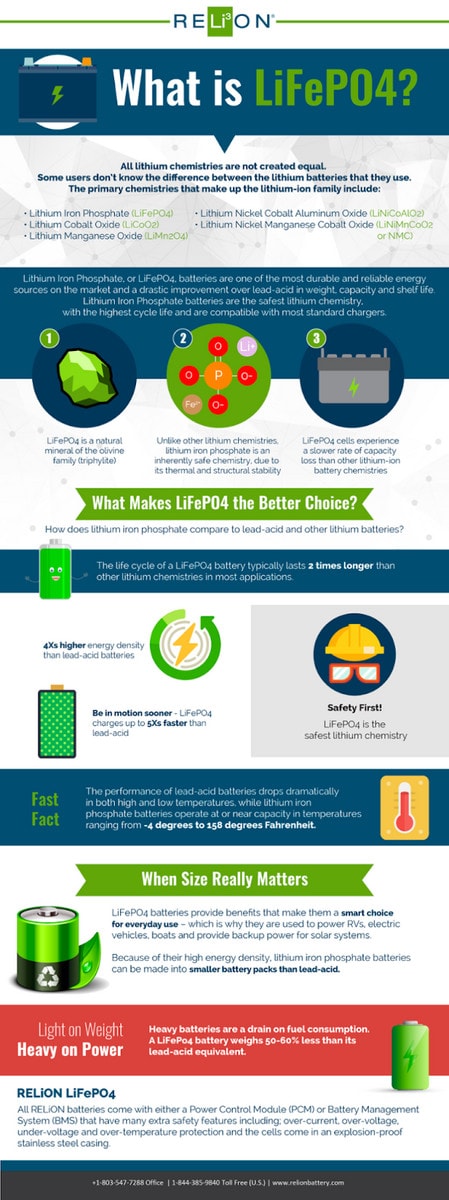
Lithium batteries are a lot simpler to set up in your vehicle too:
- Remove your old starting battery
- Replace it with the lithium version (make sure it’s one that’s capable of starting a vehicle, like this one)
- Use a wiring kit and fuse box to run 12V power from the battery to your vehicle
- Use waterproof connectors to outlets for your devices and home comforts while traveling
There’s no inverter, web of heavy gauge wire, or DC-DC chargers to contend with. Plus, you save precious space in your engine bay as you don’t need a second battery tray.
While there are many positives, you’ll still need to remember the risks of running on a single battery. Lithium batteries are also more expensive than their lead-acid counterparts and need specific chargers to run.
Lithium technology is constantly evolving. So, do your research to meet and afford your power needs (and make sure to bring a portable jump-start pack in case of power failure).
If you're looking for the ultimate solution for going off-grid, this is it. 11-year warranty and over 5,000 recharge cycles.
3. Utilizing a Solar Generator As Your Second Battery
If you’ll be stopping frequently for extended periods on your overlanding trip, you’ll need to think about other power sources for battery charging.
You may already be using solar panels as part of your power setup. If you’re going to be in an area with strong sunlight, this could be all you need. Adding a solar charge controller will also help regulate the power coming from the panels to the battery bank.
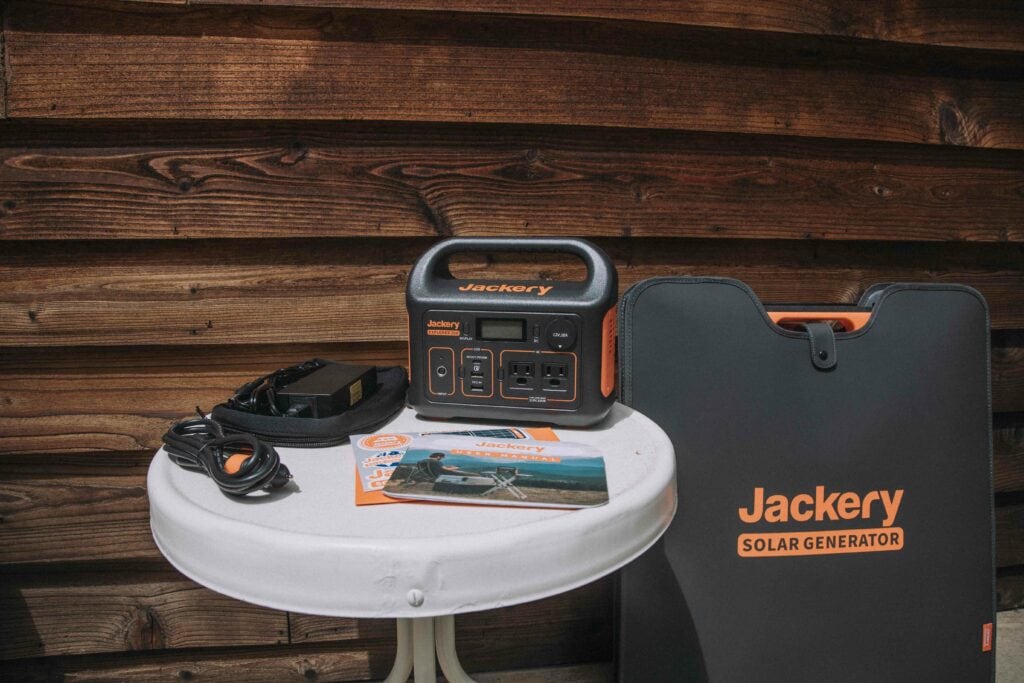
Portable solar power stations like the Jackery 300 usually include a battery, controller, and power inverter in one convenient portable box. Just be aware that the size of your panels or generator will limit the amount of power you have to work with.
You’ll need enough storage space to store it or mount panels on your vehicle. So, check the dimensions and make sure it’ll definitely fit into the physical space you have available before investing a lot of money.
Your DC charge rate is the next factor to consider. If it can’t charge fast enough or from a 12V car outlet, it won’t be practical as a dual battery setup for camping in your vehicle.
The costs of solar generators vary quite considerably. Depending on your budget, a traditional dual battery setup may be more cost-effective if you’re looking for above 1500 watts capacity.
Related Reading: Are Solar Panels Good for the Environment?
Dual Battery Installation
Traditional dual battery setups can be tough to install for regular folk. Whether it’s a Toyota Tacoma, Land Cruiser, or Jeep Wrangler, you’ll need to wire up:
- An additional battery (we recommend this one by LiTime)
- A dual battery isolator or DC-to-DC charger to protect both systems
- An inverter (if you need AC power)
- A properly gauged cable to combine everything
Wiring multiple battery terminals to an alternator can also cause it to overheat and melt if not done correctly. If it’s wired properly, it shouldn’t do any damage. If you’re unsure, consult with a trained professional.
Here are some tips if you’ll be doing it yourself:
You need to keep both systems separate to make sure one battery failing doesn’t affect the other. The auxiliary battery can drain the starter battery if it isn’t wired properly.
The Best Dual Battery Setup Is Down to You
Having an extra battery to rely on isn’t just a nice addition to your overlanding gear list. It could be the difference between getting out of a potentially sticky situation while off-grid and not.
The type of setup you choose will depend on the size of your vehicle, your budget, and power needs. The market and technology are both constantly evolving, so do your research and keep an eye out for options that may not have been available the last time you checked.
That said, here is my recommendation if you want dual batteries:
- 2x 50Ah 12V LiFePO4 Batteries
- A DC/DC Charger to charge both batteries from the alternator
- Heavy gauge DC wiring (0, 2, 4, or 6 depending on the length and power draw)
- A Pure Sine Wave Inverter (if you want to use AC power)
Keep in mind, that you can also simply replace your car battery with a lithium one or you can use a solar power generator in place of a secondary battery, if you prefer simplicity or want to save money.
New to overlanding? Check out our handy guides on the gear you’ll need, vehicle types, and storage options:


